My experience is that, while both drip irrigation and micro-sprinklers work well to deliver water to fruit trees in Southern California, they come with advantages and disadvantages. And one method is not best for all situations.
Because of this, even in my own single yard, I use drip on some of my fruit trees but micro-sprinklers on others.
My goal in this post is to help you decide which might work better on your trees in each of their contexts.
What are drip irrigation and micro-sprinklers?
Before diving into the pros and cons, let me be clear on what I mean by drip irrigation. I mean tubing that has emitters (essentially, holes) which allow water to slowly drip out.
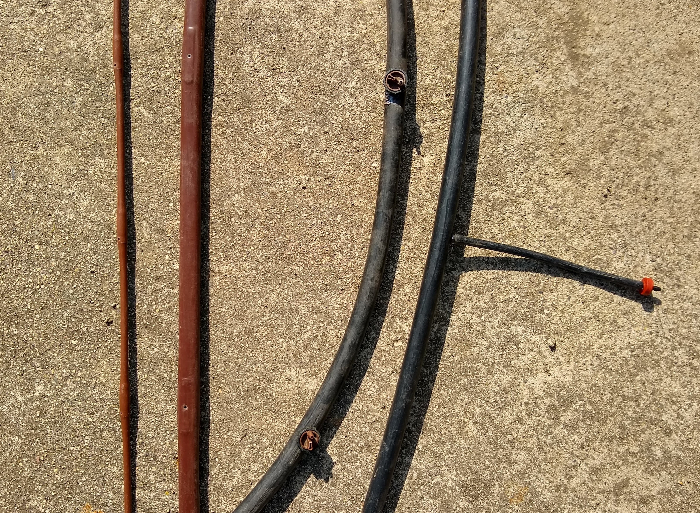
By micro-sprinkler, I mean a product that spits out water either in a stationary pattern or in a spinning pattern.
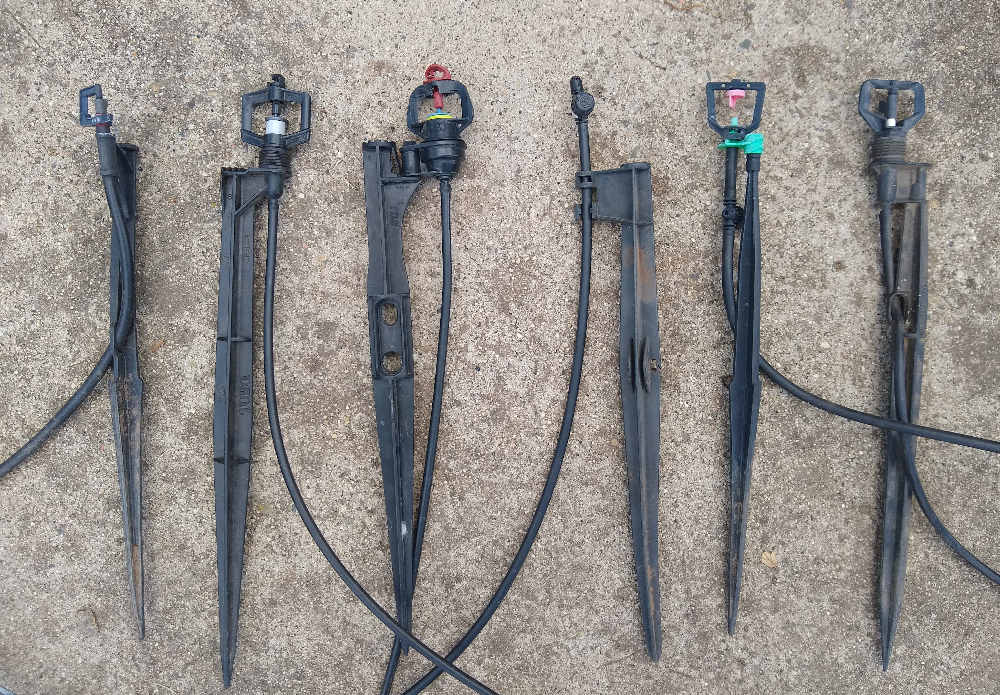
Pros and cons
Now for the pros and cons of each. Pros first.
Drip irrigation: PROS
1- Drip emitters apply water in the same location no matter the water pressure. In contrast, with micro-sprinklers, a change in water pressure makes the spray from the sprinkler go different distances. For some homes, a significant change in water pressure can happen if a clothes washing machine is running, someone takes a shower, or a hose is turned on elsewhere in the yard. And the advantage of drip emitters always applying water in the same spots is that the tree’s roots can proliferate in those exact spots and always access the applied water.
2- Drip emitters apply water in the same location no matter the wind. On a windy day (think Santa Anas), water from a micro-sprinkler is carried off. This causes the same problem as with a change in pressure, plus it can cause much of the water to be vaporized.
3- You can run a mower or string trimmer over drip tubing without causing damage. I find this convenient. On the other hand, you must be careful to avoid running over micro-sprinklers when managing weeds with these tools.
4- You can use non-pressure compensating drip emitters in order to apply rainwater from a tank. Even though the pressure is very low, these drip emitters will work (just at a lower rate). However, micro-sprinklers don’t work on such low pressure.
5- On a slope, drip emitters that have check valves can prevent water from “bleeding out” of the low-elevation emitters. Netafim’s Techline CV is one example of such a product. I use this on some of my trees at the bottom of my slope so that I can irrigate more uniformly up and down the slope.
6- With drip, it’s easy to estimate how much water you are applying. You just count the emitters (of known output) and multiply by the run time. For example, if under a particular tree you have eight emitters that each apply 0.5 gallons per hour, and you run the line for an hour, then you have given the tree four gallons.
7- You can use less water because drip does not wet a large surface area that is subject to evaporation whereas micro-sprinklers do.
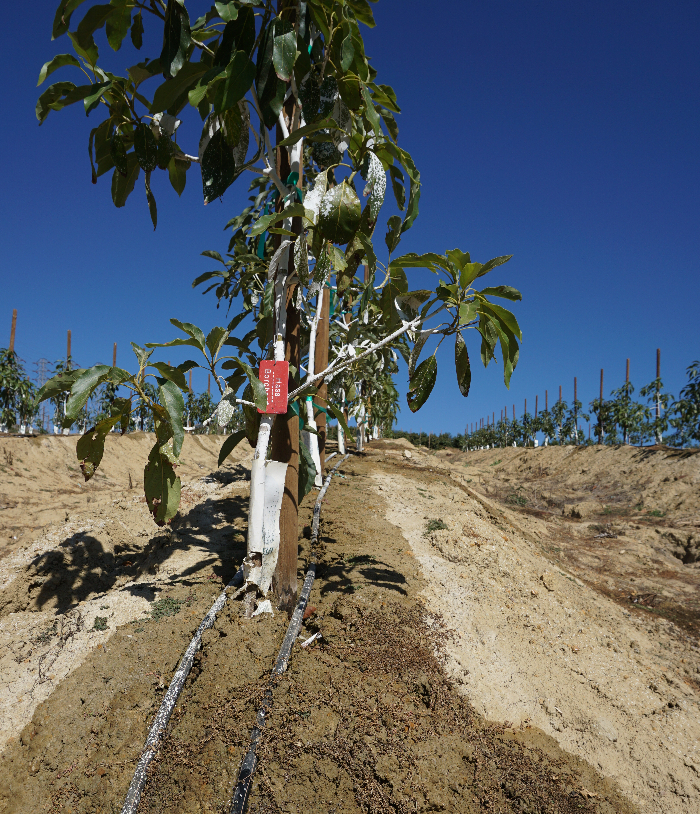
Drip irrigation offers many advantages, but micro-sprinklers have a few advantages too:
Micro-sprinkler PROS
1- It’s easy to spot a clogged micro-sprinkler. Water not coming out of a micro-sprinkler is obvious. In contrast, a clogged drip emitter is hard to notice unless you bend down and lift up the line and observe each emitter.
2- It’s easy to increase or decrease water to a growing tree by adding a valve to the micro-sprinkler’s line or by switching sprinkler heads. (They make adjustable drip emitters and adjustable sprayers and sprinklers, but I don’t like them, as they tend to “adjust” themselves and unpredictably put out more or less water.)
3- Micro-sprinklers don’t get buried in mulch. Driplines get buried by falling leaves and prunings, and definitely by applied wood chips. So with driplines, you must periodically (once or twice per year) lift them above the mulch or else roots will grow over the lines and you’ll have to damage roots in order to do any maintenance or alterations to the dripline later on.
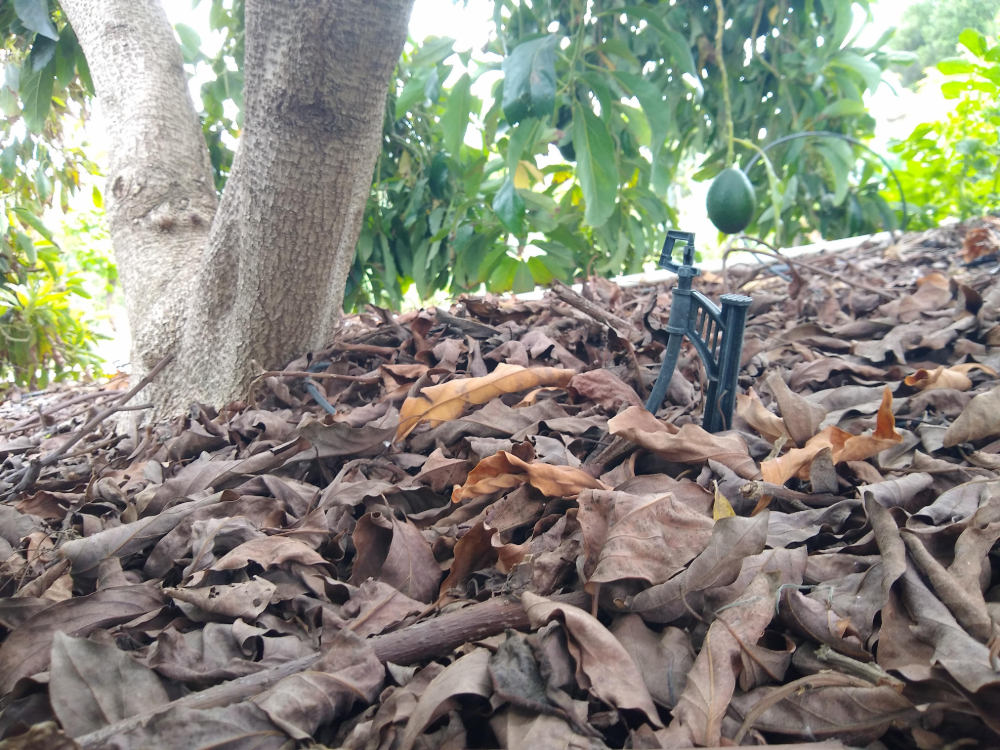
Now for a couple cons:
Drip irrigation: CON
Lots of product and plastic. A tree of any size can thrive on only one micro-sprinkler, but it may need many feet of dripline and multiple emitters if using drip irrigation.
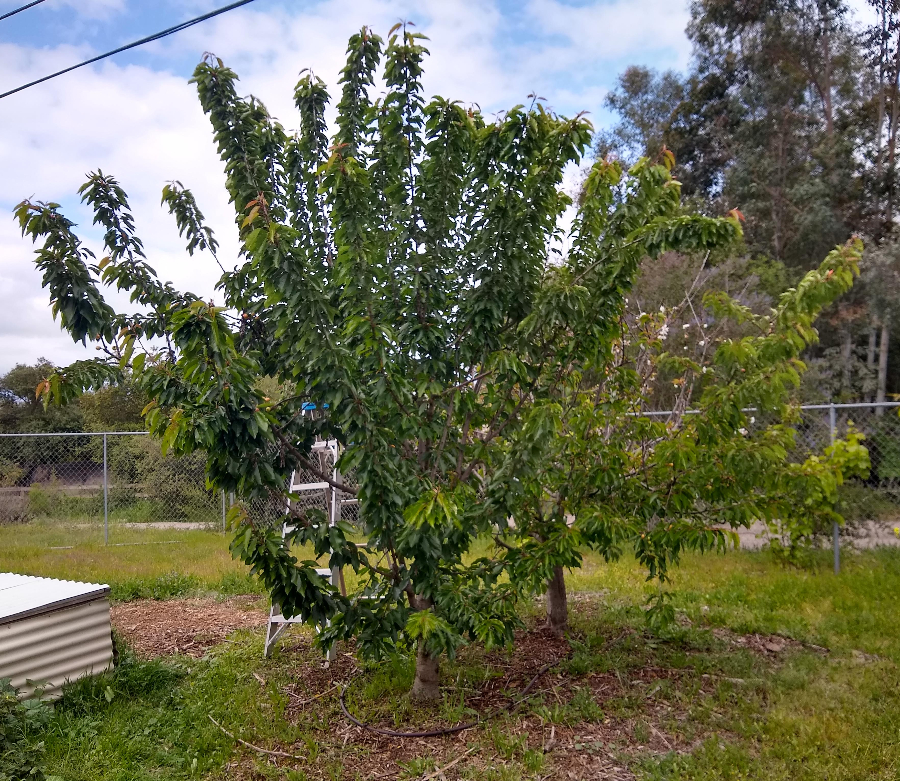
Micro-sprinkler: CON
Water can be blocked by low branches and tall weeds. You must “skirt” trees and keep up on the weed maintenance more with micro-sprinklers, especially on young trees.
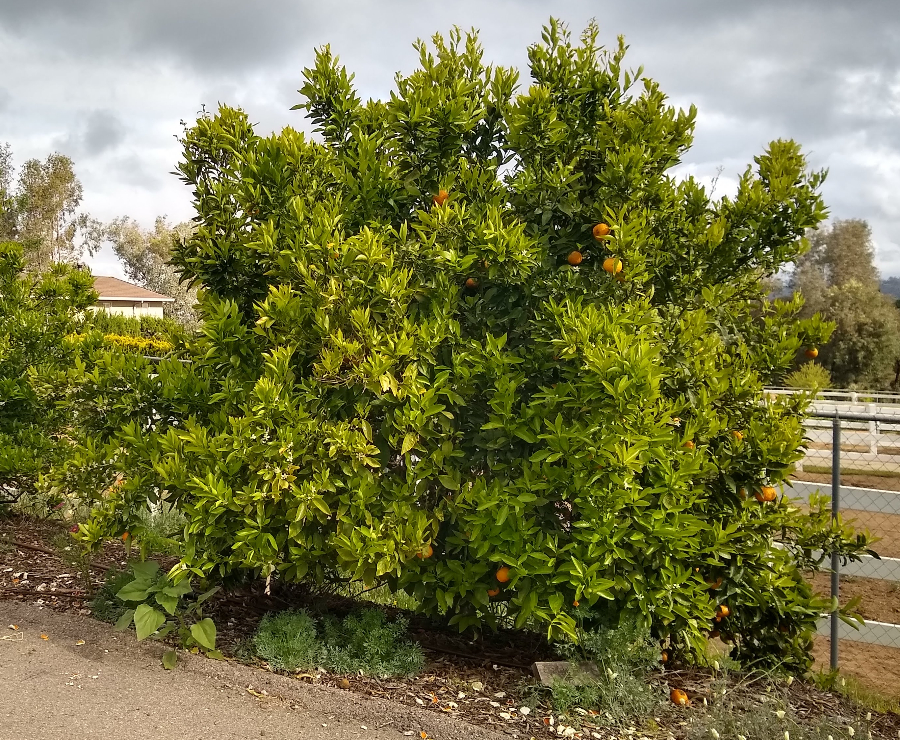
Cost comparison of drip versus micro-sprinkler
Using components similar to those that I use to irrigate my trees with micro-spinklers or drip, and taking current (April 2025) prices from a single online retailer (Drip Depot), I did a rough cost comparison for each irrigation method on an imaginary mature tree of about ten feet in diameter.
Drip Depot’s pressure-compensating dripline with emitters of one gallon per hour at 12-inch spacing costs $35 for 100 feet. I would use about 20 feet under such a tree, which would cost $7.
A Netafim micro-sprinkler costs $3. I often add a valve to my micro-sprinklers so that’s an additional $0.69, for a total of $3.69.
Conclusion: the materials cost about twice as much for drip.
(Assuming water savings with drip though, the lower water cost would eventually pay for the higher cost of the dripline.)
Situations where drip or micro-sprinklers are the better choice
I find that drip is often the better choice on a young fruit tree because young fruit trees need water more frequently than older ones. With drip, you can water often – even every day – without losing much water to evaporation.
Therefore, what I usually do is start fruit trees on drip. Later, around the time the tree’s canopy is ten feet in diameter, I might switch to using a micro-sprinkler. (The original dripline can be reused elsewhere.)
Bigger, older fruit trees are prime candidates for micro-sprinklers. They can be watered relatively infrequently, thereby minimizing evaporative loss and disease issues with wetting trunks (you don’t want to wet a tree’s trunk often).
Therefore, many of my mature fruit trees have micro-sprinklers, especially my deciduous fruit trees, as they need water no more than once per week in summer.

Do you have chickens that roam among your trees? If you do, you might find micro-sprinklers better. My chickens love to scratch under my fruit trees, which doesn’t affect the staked micro-sprinklers, but for the trees that have driplines it’s an annoyance. The driplines get moved by the scratching chickens no matter how well I stake them down.
Bottom line
I find myself continuing to use both drip irrigation and micro-sprinklers on different fruit trees of different ages in different parts of my yard because of the above advantages and disadvantages.
Thanks for your support so I can keep the Yard Posts coming and ad-free.
Related posts you might enjoy:
Watering fruit trees with drip irrigation
Setting up micro-sprinklers under fruit trees
Drip and micro-sprinkler troubleshooting guide
How much to water a fruit tree in Southern California, roughly

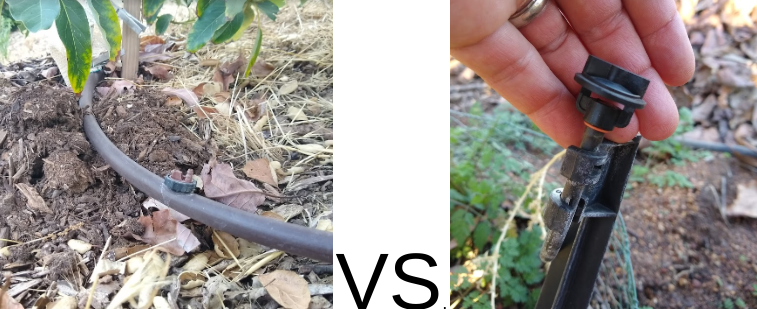


A couple of CONs that I have with drip heads, I used the flag drippers, then changed to those adjustable multi-stream dripper sprinklers, since I get better coverage, in some cases, but I found that something destroys them. I actually have to replace them every few months. I think it’s either possums or rats, maybe even squirrels, but they chew them until they have large holes and are non-functional. Sadly, my weed whacker seems to get them at times too 🙂
I am in zip code 92120. I’ve seen possums, raccoons, lots of rats, and coyotes. I had several quarter inch drip tubing lines chewed apart by a coyote. I finally put a tray of water out there where they chewed hoping they just wanted the water. I also put five rat traps around where the lines were to nail any animal that was doing it. It stopped after a couple weeks and some sprung traps.
I’ve experienced destruction of sprinklers by ground squirrels. They are thirsty and chew them. Why can’t they just wait for watering time?
I also have a water bowl out, but they ignore that and rather chew the drip sprinklers, I have a feeling that including the water present, they like chewing on that plastic?
I’ve heard that rodents have to keep chewing to keep their teeth from growing too long, the varmints!
I had a smart coyote that would chew the garden hose. The hose squiggled horizontally a long distance on a slope, it would chew the low spots for the water. Destroyed several hoses. The coyote was neutralized.
Thank you so much for this article, for taking the time to write it. Really informative.
Greg,
I recently went back to all drip for my citrus, avocado, nut and fruit trees. Have been through drip, bubblers, micros and back to drip, perhaps for good. Why? Difficulty of maintaining micro “ring” consistency, several newer trees that only need 3-4′ rings which my micros can struggle with, and my doberman can no longer knock over the micros while she’s stealing her unfair share fruit!
These articles, and past ones, always help me better sift through my approach and set my direction. Appreciate all your experience/analysis and your wonderfully condensed simplicity through words.
A couple of notes: about 3 years ago, I had circular 1/2″ Netafim drip line that was 3 years old on an avocado tree that was planted from a 15 gallon container.
It was summer and I had a banner crop of fruitlings in the summer that started to drop. I lost the whole crop for that year….. the cause was Dripline being clogged by calcium/magnesium deposits from the water….. That was a tough lesson to learn. I purchased an 18″ moisture meter to help diagnose the issue since those lines were staked in place and covered w old avocado leaves.
Point # Ive got a steep slope and needed to place 1/2″ drip lines running parallel to the slope./ The steep slope caused the lines at the top of the slope to get less water than at the bottom of the slope. I had new bushes planted in strategic places to stabilize the slope. To remedy the situation I used “Pressure Compensating” drip lines (Netafim) as Greg Alder suggests and ran a 3/4″ PVC pipe from top to bottom at the right hand side of the slope and “T’d” off every 5 ft from the PVC with perpendicular Drip lines… each branch had a valve installed which allowed me to vary the volume of water from the top line to the bottom line……it seemed to work for me…. your mileage may vary.
Also, Greg , would you please add me to the contributors list . See paypal 3/19/25 , see correspondence on 3/28. Thanks
Although this is NOT on the topic of watering, I have a “SERIOUS” issue…. well, serious to me.
I’ve got a big rat which is raiding my 2 avocado trees. Haas , Pinkerton. I’ve installed a ring doorbell camera and I can see when that little “sob” raids the tree. Between 9PM and 2AM. I’ve lost at least 20 avocados to him/her.
The trees are adjacent to a fence so trimming the tree is out of the question, the trunks branch low on the ground so a metal barrier does not work. This rat is verry skittish and cautious
The issue is…. the rat is only interested in avocados. I’ve tried Victor traps, trap door traps into a bucket traps, cages to catch him …. no go. I’ve used, almonds, walnuts, mayonnaise, chicken meat, seeds, macadamia nuts AND even cut, ripe avocado in the traps….No Go….. he nibbles at the stem, avocado falls, nibbles further and goes to avocado #2 for the night. Condolences or tips on how to deal with this issue requested….
Al G
Hi Al,
What a greedy rat! Maybe the paper plate guard would work? Long term, cats are the best solution I know. See this post: https://gregalder.com/yardposts/rats-protecting-your-garden-fruits-and-vegetables/
Hi Greg
Unfortunately , our “well fed” 15 year old cat is no longer a deterrent, also, at 1AM in the morning, our outdoor cat is sawing logs at the other end of our small yard… I had indeed read your article previously. Thanks for the response.
Just a note…I recently purchased a “trap door” type Rat Trap and I am hopeful this will come to my aid….
Avocado advice requested….. Ive got a Pinkerton and Haas tree with a fair number of now ready to harvest fruit.
Old leaves are falling , new leaves are sprouting. Two years ago I decided to leave ALL avocados on the tree as my storage location….. I was harvesting into August…. Flowers blossomed on the tree and NO fruitlets were produced which remained on the three trees which I have …..(the other is a Sir Prize). I kept the mature avocados on the trees way past the flowering stage.
I’ve not had avocados for 2 years and this is the first year w ith a great crop since then.
Here is the question ???? Do I harvest all of the avocados before, during or later into the flowering of the trees . I’ve read that storing the avocados on the tree hampers new fruitlets from remaining on the tree….. your sage advice is requested….
Hi Al,
I’ve seen studies done on this topic, and I’ve got some personal experience to relate.
The problems with the studies are the same old problems with most contemporary harvesting studies on avocados: they are only done with the Hass variety; and they only use typical commercial-style harvesting.
Typical commercial-style harvesting is not removing a single avocado until one day removing all the avocados at once (“strip harvesting”). This is vastly different from how a home grower harvests.
Nevertheless, the studies don’t indicate that harvesting all of the fruit from a tree in spring during bloom will increase the amount of fruit set that same spring.
Here are two studies you can look at:
1. Lovatt, 2010: https://www.avocadosource.com/cas_yearbooks/cas_93_2010/cas_2010_v93_pg_125-140.pdf
2. Graham, 1991: https://www.avocadosource.com/Journals/SAAGA/SAAGA_1991/SAAGA_1991_PG_27-37.pdf
My advice is that you should pick avocados off any home tree whenever you want to eat them and they taste acceptable. Start as soon as they taste good enough and pick at the rate that fulfills your needs.
The behavior of your Pinkerton, Hass, and Sir-Prize trees is likely due to the trees’ need to recover from a crop. Varieties and individual trees differ, but sometimes they take one year to recover, other times two. Often, the weather and care (water, etc.) are important factors too.
By the way, this is totally different from removing a young crop right after the fruit has set (in May or June, e.g.), which definitely does result in more vegetative growth during summer and more bloom the following spring.
Thanks to you and your articles, I googled Dr Carol Lovatt and using her article below
https://ucanr.edu/sites/default/files/2020-03/322231.pdf
I ordered some Gibberellic powder and will attempt an equivalent of ProGibb LV.
I will make a solution equivalent (or close) to the ProGibb LV concentration and will be spraying my flowering Avocado when its time.
Now, based on her article, timing is important.
Look, what have I got to lose? Ive had my 3 trees in the ground since 2016. I bought the Haas, Pinkerton and SIr Prize avocados in 15 gallon containers.
My best yield has been the Haas, the best taste is a toss up between the Sir Prize and Pinkerton.. The Haas is damned good however,.
The Haas has been the most prolific , the other two ….spotty at best for production.
This season, I removed ALL Sir Prize avocados well before final flowering. At the end of the flowering stage ( I live near the coast), ZERO flowers have turned into fruitlets. We have got many bees , that’s not the reason.
So….. short story long…. I will be doing a foliar spray on my Haas and Pinkerton trees when flowers are at the “appropriate stage”. Yeah , its a guess for me.
But, since my guess is that all trees will skip a year of production, what have I got to lose?
Also, thanks to YOU Greg, I will be Girdling my trees in the late Fall….
Also, I am gonna use the Gibberellic acid on some strawberries and blueberries flowers.. Perhaps I will get some grapefruit sized strawberries? : )
Thanks Greg, this is starting to become fun !!
More questions. .Storage of Avocado’s… I’ve got 2 Avocado trees with a fair amount of fruit on them now. I am gonna have to harvest all of them soon. (because I’ve read that if I don’t, I wont get a crop next year)
I’ve given avocados to neighbors and friends and now want to somehow successfully freeze some.
I’ve experimented with freezing avocado’s whole, mashing them w lemon juice and freezing in small vacuum sealed bags.
The result is…. something significant is lost in the process…. they don’t taste as creamy, the consistency is lost…
I am wondering if quick freezing with “dry ice” in a styrofoam container and vacuum bags might help?
Has anyone out there got a sure fire way to maximize the magic of the avocado taste for storage in a freezer?
Had to ask… Any suggestions welcome.
Thanks
I’m no expert, but so take (or don’t take) my advice with a grain of salt. There’s no generic reason that you won’t get a crop next year if you leave this year’s avos on there. I don’t know what variety you have, from my limited experience younger trees are often alternate bearing, that is more fruit one year and less (or none) the next.
I have 3 trees, Hass, Fuerte, and Reed.
The Hass is the oldest, planted around 12 years ago. I got about 30 fruit for the first time in 2018, then zero in 2019. 2020 -2024 was 70, 128, 107, 195, 238. This doesn’t count the ones on my neighbor’s side of the fence that they enjoy. The last few years I’ve been picking avos from March to October.
The Fuerte and Reed are much younger, but also started with a dropped yield the second year.
Leave your fruit on the tree, and just enjoy it. Maybe you’ll get fewer next year, but even if you pick it all now you may get none to fewer next year.
Hi Greg, initially had all my avocados and citrus trees on drip. The avo’s were young and did nothing for 2-3 years. Then I learned that something like 96% of avocado roots are in the top 6 inches of the soil. No brainier, mini sprinklers. They took off. Left the citrus, figs and others on drip but didn’t know how to fertilize them on drip, other than buying an expediencies system. So now I use drip and mini sprinklers on most all of my trees. I water at night to minimize evaporation.